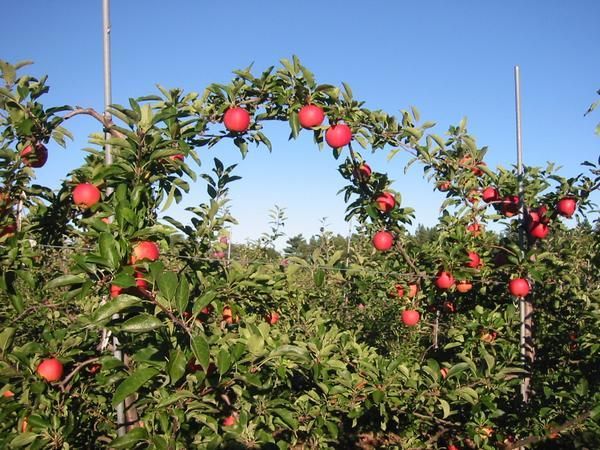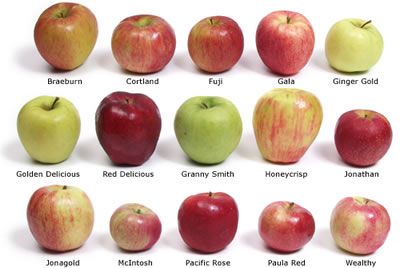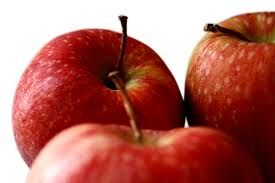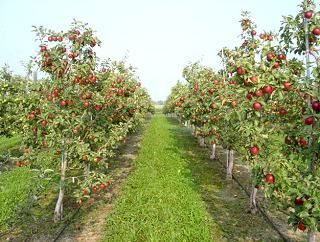Apple
|
|
|
Apples require a fair amount of patience and planning. If you want a choice crop, you'll have to control insects, diseases, and other pests, keep an eye on the weather, and prune annually. And your first harvest will only come 3 years or more after planting. But the reward picking apples from your own garden is worth the effort.
Orchard Planning
When setting up a home orchard, you will find there are dozens of apple varieties to choose from. Talk to local nursery people, your county extension service agent, or other gardeners to help you select varieties that do well in your area. Rootstock choice determines whether a tree is a dwarf, semidwarf, or standard size. Dwarf trees grow to be 8 to 12 feet tall and just as wide; semidwarf trees grow to be 12 to 18 feet tall and wide; and standard trees grow to be 18 to 22 feet tall and wide. In general, semi-dwarfing rootstocks for apples are recommended, if space permits, as true dwarfs are somewhat less hardy and therefore less suited to the coldest parts of the country.

The same rootstock combined with different varieties will produce trees of different sizes with differing degrees of vigor.
Choose a site with full sun, moderate fertility, and good air circulation and water drainage. Apple trees will tolerate a wide range of soil conditions. While you can improve your soil with fertilizer and mulch, other factors -- full sun, good water drainage, the right varieties, and loving care -- will go a long way toward overcoming less-than-perfect soil.
Planting Particulars
In the North, plant as early in the spring as possible. In the South where fall and winter weather is moist and mild, fall planting works well; it gives the roots a good headstart on spring.
Dig a hole a foot wider and a foot deeper than the root ball, then partially fill it with topsoil or compost. Space standard trees 30 to 35 feet apart, semidwarfs 20 to 25 feet apart, and dwarfs 15 to 20 feet apart. Pound in a stake on the downwind side for support. Support is not essential for semidwarfs, but it is still a good idea for the first few years.
Place your tree in the hole and spread the roots carefully. With dwarf or semi-dwarf trees that have only one graft, make sure that the graft union (a small swelling near the base of the trunk) remains at least 1 inch above ground, or the upper variety will take root and override the desired influence of the rootstock.
Deep planting of both rootstock-dwarfed and interstem-dwarfed trees results in better tree anchorage and fewer suckers growing up from the roots. However, planting trees much deeper than they grew in the nursery can increase problems with crown rot. With interstem varieties, the interstem section should be half above and half below the ground.
Before you fill the hole, place a mouse guard around the trunk to extend about 10 inches or so above the ground. Water your fledglings thoroughly. Then mulch with clean straw or some other weed-free organic material to keep the moist and to control weeds.

Planning
- Select resistant varieties to minimize apple scab and other disease problems.
- Apple trees are not self-fertile; plant at least one other variety that blooms at the same time. Flowering crab apples that bloom at the same time will also pollinate apples.
- Buy dormant, bare-root, 1-year-old trees, if possible. Dwarfs and semi-dwarfs will bear in 3 to 4 years, yielding 1 to 2 bushels per year. Standard-size trees will start to bear in 4 to 8 years, yielding 4 to 5 bushels of apples.
Preparation
- Choose a site with full sun, moderate fertility, and good air circulation and water drainage.
- Apples will tolerate a wide range of soil types.
Planting
- When planting trees on dwarfing and semi-dwarfing rootstocks, be sure the graft union stays at least 1 inch above ground.
- Space standard trees 30 to 35 feet apart, semi-dwarfs 20 to 25 feet apart, and dwarf trees 15 to 20 feet apart.
- Water, prune, and mulch young trees right after planting.
Care
- Water young trees regularly, especially those on semi-dwarfing or dwarfing rootstocks, to ensure that the root system becomes well established.
- Renew the mulch periodically, but pull it away from the tree in the fall so mice don't nest over the winter and eat the bark.
- Begin training trees to their permanent framework in the first season.
- Prune bearing trees annually.
- The harvest season ranges from midsummer to late fall, depending on the variety.
Articole asemănătoare
-
Cocktail Red Apple
Reteta perfecta atunci cand isi doresti in acelasi pahar gustul dulce-acrisor de mar si cel de vodka de calitate.
-
Deco-sol, ideal pentru aranjamente florale
Deco-sol este un material de sinteza, ce ofera necesarul de apa si substante nutritive pentru multe plante de apartament.
-
Gradini pe acoperisurile cladirilor
Daca in trecut o gradina luxurianta pe terasa blocului parea doar o utopie, astazi tot mai multe orase pun in practica aceasta idee, iar Chicago se numara printre ele, avand in chiar centrul sau o oaza de verdeata si prospetime, la inaltimi unde se avanta doar pasarile.
-
Sulcorebutia rauschii
Sulcorebutia rauschii iubeste pamantul foarte permeabil, grunjos, mineral, precum si sa fie tinut intr-un mediu foarte uscat pe perioada de iarna, pentru ca este foarte sensibil la excesul de umezeala.
-
Apple Seed
Ingrediente: 1 parte Tequila 1/2 parte Creme de Cassis

